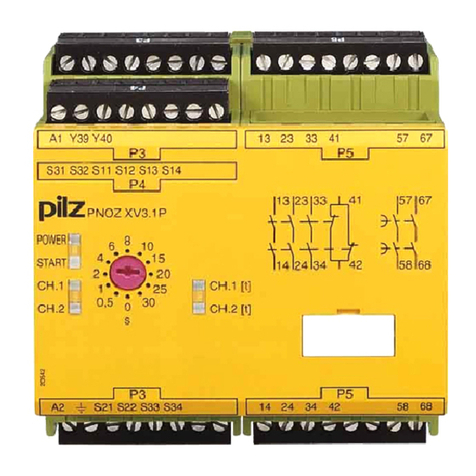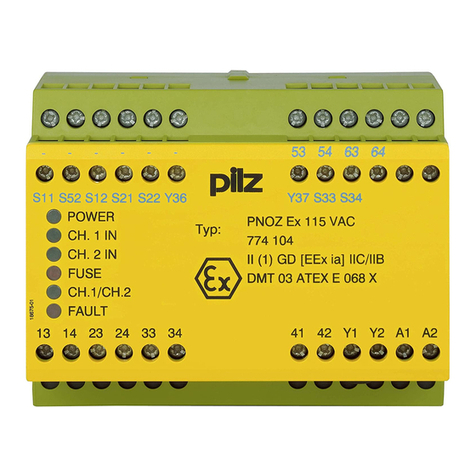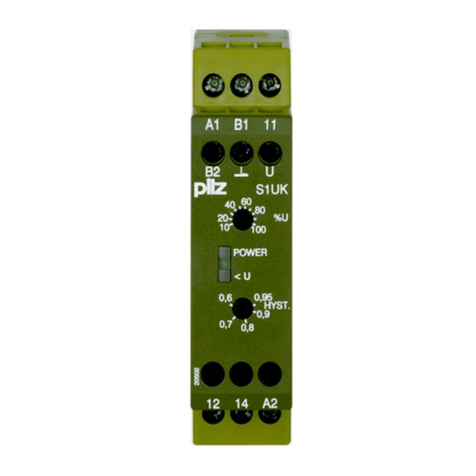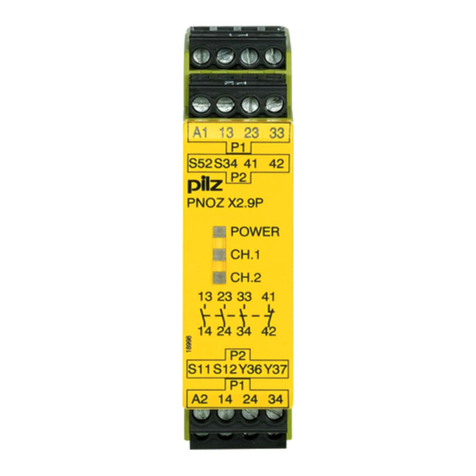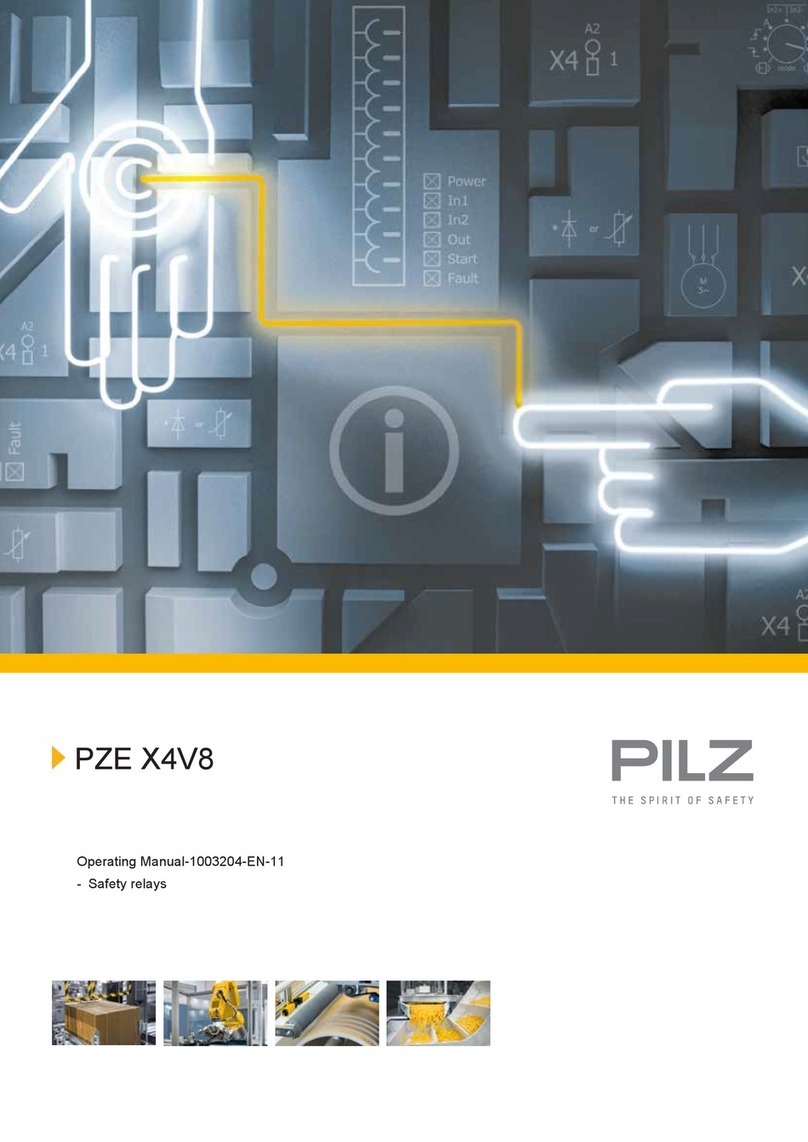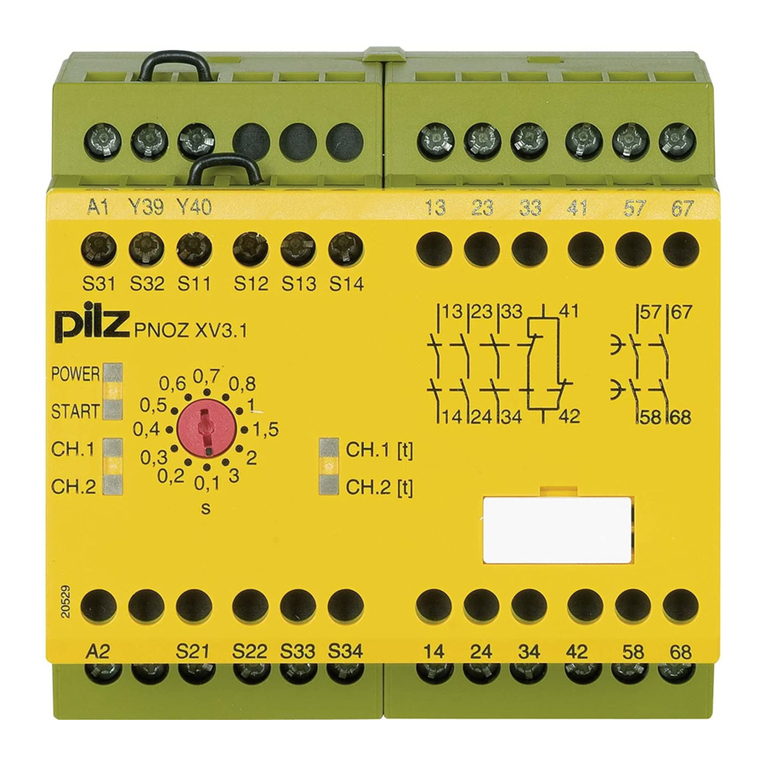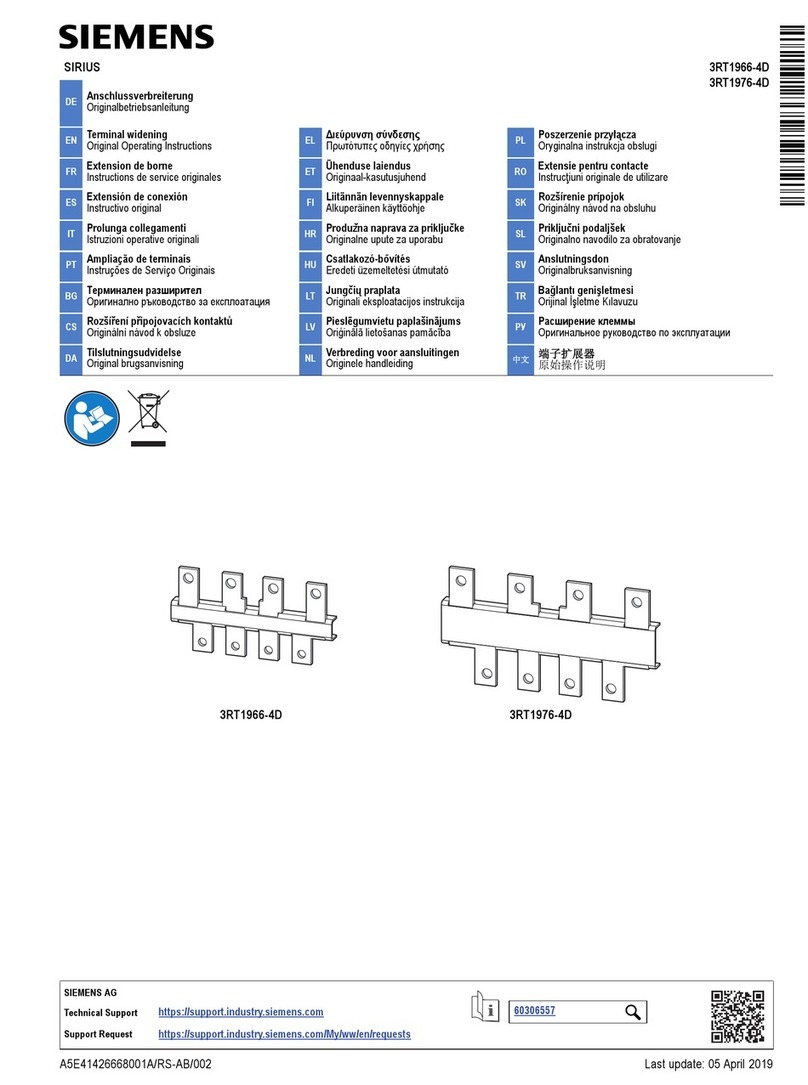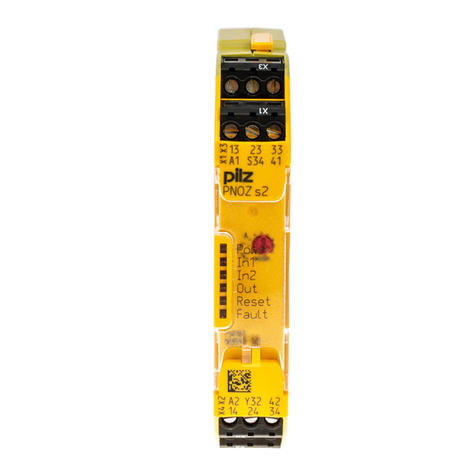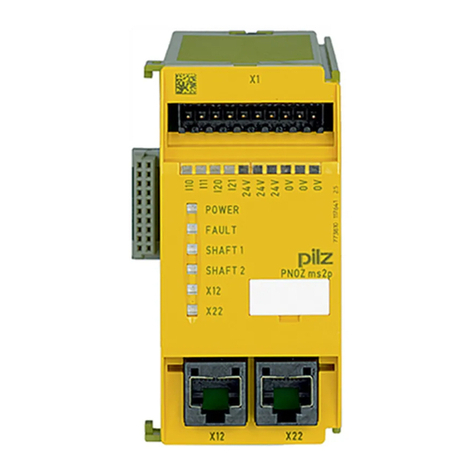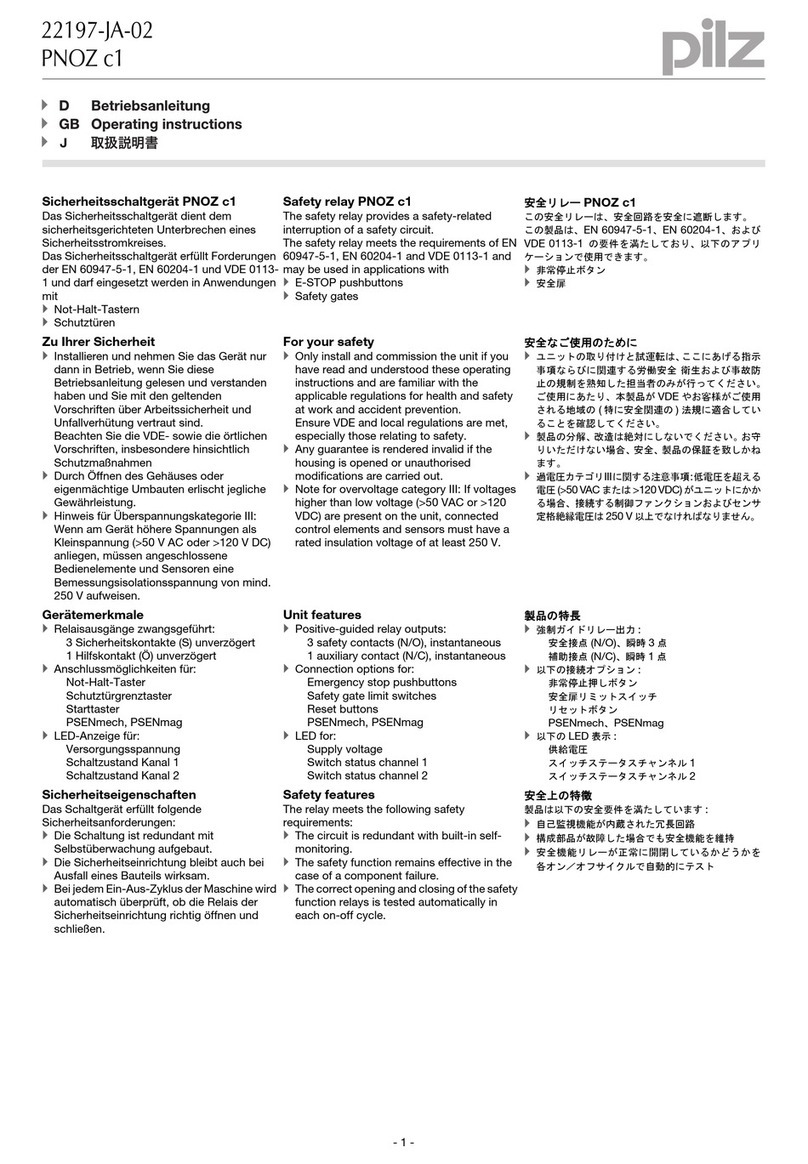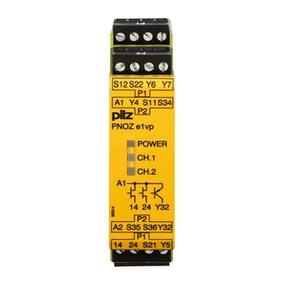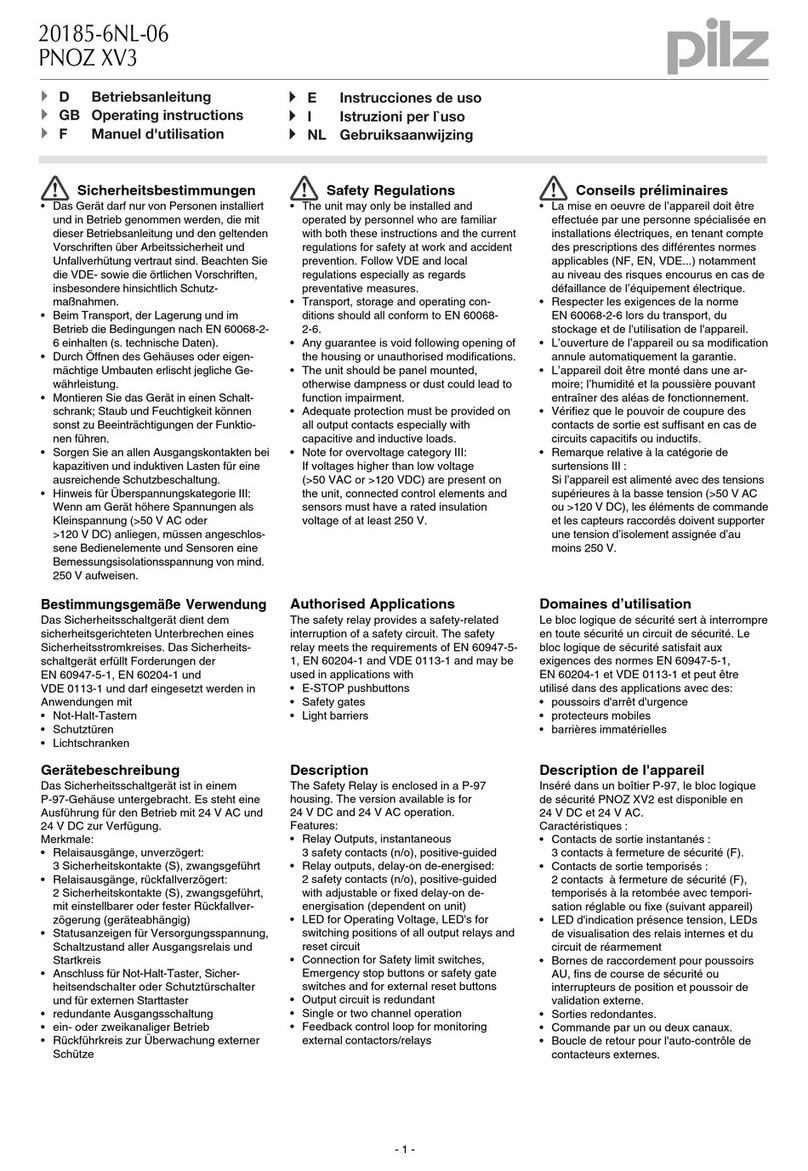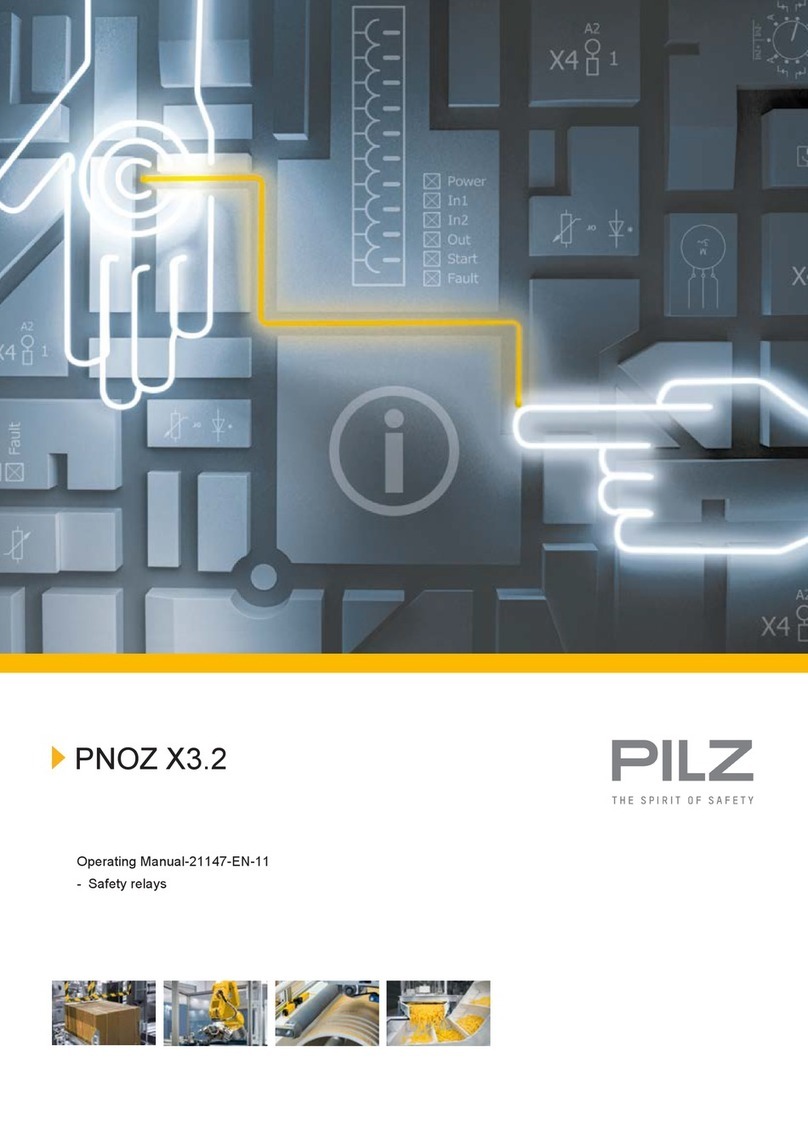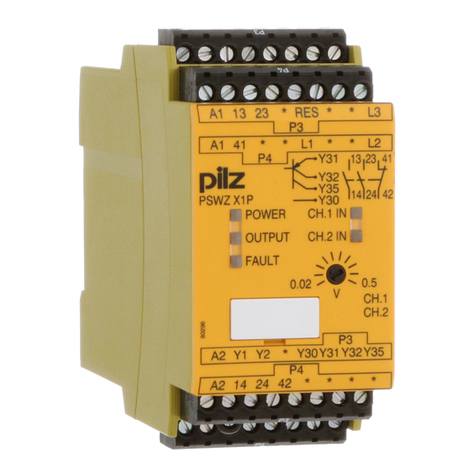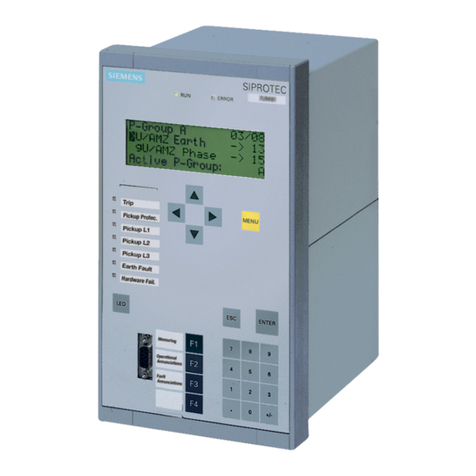
- 3 -
• Kontaktvervielfachung und -verstärkung
durch Anschluss von externen Schützen.
• Augmentation du nombre de contacts ou
du pouvoir de coupure par l’utilisation de
contacteurs externes.
• The number of safety contacts can be
increased by connecting expander
modules.
Inbetriebnahme
Beachten Sie bei der Inbetriebnahme:
• Nur die Ausgangskontakte 13-14/23-24/
33-34/43-44/53-54/63-64 sind Sicherheits-
kontakte. Ausgangskontakte 71-72/81-82/
91-92/01-02 sind Hilfskontakte (z. B. für
Anzeige).
•Vor die Ausgangskontakte eine
Sicherung (s. technische Daten)
schalten, um das Verschweißen der
Kontakte zu verhindern.
• Berechnung der max. Leitungslänge Imax
(Eingangskreis):
R
lmax
R
l
/ km
I
max
=
Rlmax = max. Gesamtleitungswiderstand
(Eingangskreis)
Rl/km = Leitungswiderstand/km
• Da die Funktion Querschlusserkennung
nicht einfehlersicher ist, wird sie von Pilz
während der Endkontrolle geprüft. Eine
Überprüfung nach der Installation des
Geräts ist wie folgt möglich:
1. Gerät betriebsbereit (Ausgangskontakte
geschlossen)
2. Die Testklemmen S12-S22 zur
Querschlussprüfung kurzschließen.
3. Die Sicherung im Gerät muss auslösen
und die Ausgangskontakte öffnen. Lei-
tungslängen in der Größenordnung der
Maximallänge können das Auslösen der
Sicherung um bis zu 2 Minuten verzögern.
4.
Sicherung wieder zurücksetzen: den
Kurzschluss entfernen und die Versor-
gungsspannung für ca. 1 Minute
abschal-
ten.
• Bei AC-Geräten kann kein zusätzlicher
Verbraucher verwendet werden. Bei DC-
Geräten zusätzliche Verbraucher mit max.
250 mA.
• Leitungsmaterial aus Kupferdraht mit einer
Temperaturbeständigkeit von 60/75 °C
verwenden.
• Sorgen Sie beim Anschluss von magne-
tisch wirkenden, auf Reedkontakten
basierenden Näherungsschaltern dafür,
dass der max. Einschaltspitzenstrom (am
Eingangskreis) den Näherungsschalter
nicht überlastet.
• Angaben im Kapitel „Technische Daten“
unbedingt einhalten.
Ablauf:
• Versorgungsspannung an Klemmen A1 (+)
und A2 (-) anlegen.
- DC: Klemme A2 (-) mit geerdeter Seite
der Versorgungsspannung verbinden.
- AC: Betriebserdungsklemme mit
Schutzleitersystem verbinden.
• Eingangskreis
- Einkanalig: S12-Y3 und S21-S22
brücken. Öffnerkontakt von Auslöse-
element an S12 und S11 anschließen.
Operation
Please note for operation:
• Only the output contacts 13-14/23-24/33-
34/43-44/53-54/63-64 are safety contacts.
Output contacts 71-72/81-82/91-92/01-02
are auxiliary contacts (e.g. for signalling).
• To prevent contact welding, a fuse
should be connected before the output
contacts (see technical details).
• Calculate the max. Cable runs Imax (Input
circuit)
R
lmax
R
l
/ km
I
max
=
Rlmax = Max. Total cable resistance (Input
circuit)
Rl/km = Cable resistance/km
• As the function for detecting shorts across
the inputs is not failsafe, it is tested by Pilz
during the final control check. However, a
test is possible after installing the unit and
it can be carried out as follows:
1. Unit ready for operation (output contacts
closed)
2. Short circuit the test (connection)
terminals S12-S22 for detecting shorts
across the inputs.
3. The unit‘s fuse must be triggered and
the output contacts must open. Cable
lengths in the scale of the maximum length
can delay the fuse triggering for up to 2
minutes.
4. Reset the fuse: remove the short circuit
and switch off the operating voltage for
approx. 1 minute.
• When your external device (limit switch
etc.) has a current consumption, with DC
units this must not exceed 250 mA. With
AC units no load is permitted.
• Use copper wiring that will withstand
60/75 °C
• When connecting magnetically operated,
reed proximity switches, ensure that the
max. peak inrush current (on the input
circuit) does not overload the proximity
switch.
• Important details in the section "Technical
Data“ should be noted and adhered to.
To operate:
• Supply operating voltage to terminals
A1 (+) and A2 (-).
- DC: Connect terminal A2 (-) with the
earthed side of the operating voltage.
- AC: Connect the operating earth
terminal with the ground earth.
• Input circuit
- Single-channel: Link S12-Y3 and S21-
S22. Connect N/C contact from trigger
element (e.g. E-Stop) to S12 and S11.
- Two-channel without detection of shorts
across the contacts: Link S21 -S22.
Connect N/C contact from trigger
element (e.g. E-Stop) to S11-S12/S11-
Y3
Mise en oeuvre
Remarques préliminaires :
• Seuls les contacts 13-14/23-24/33-34/43-
44/53-54/63-64 sont des contacts de
sécurité. Les contacts 71-72/81-82/91-92/
01-02 sont des contacts d’information (ex.
voyant).
•Raccordez un fusible (voir les
caractéristiques techniques) avant les
contacts de sortie afin d’éliminer tout
risque de fusion.
• Calculer les longueurs de câblage max
Imax (Circuits d’entrée):
R
lmax
R
l
/ km
I
max
=
Rlmax = résistivité de câblage totale max.
(Circuits d’entrée)
Rl/km = résistivité de câblage/km
• La fonction de détection de court-circuit est
testé par Pilz lors du contrôle final. Un test
sur site est possible de la façon suivante :
1. Appareil en fonction (contacts de sortie
fermés)
2. Court-circuiter les bornes de
raccordement nécessaires au test S12-S22
3. Le fusible interne du relais doit
déclencher et les contacts de sortie
doivent s‘ouvrir. Le temps de réponse du
fuisible peut aller jusqu‘à 2 min. si les
longueurs de câblage sont proches des
valeurs maximales.
4. Réarmement du fusible : enlever le
court-circuit et couper l‘alimentation du
relais pendant au moins 1 min.
• Pour les relais AC, aucun autre utilisateur
ne peut être alimenté. Pour les relais en
DC, utilisateur suppl. possible jusqu’à
250 mA max.
• Utiliser uniquement des fils de cablâge en
cuivre 60/75 °C.
• Lors du raccordement de détecteurs de
proximité magnétiques, basés sur des
contacts Reed, veuillez vous assurer que
le courant de crête max. à la mise sous
tension (sur le circuit d'entrée) ne
surcharge pas les détecteurs de proximité.
• Respecter les données indiquées dans le
chap. „Caractéristiques techniques“.
Mise en oeuvre :
• Amener la tension d’alimentation sur A1
et A2
- DC : borne A2 à relier au „-“
- AC : relier la borne terre
• Circuits d’entrée
- Commande par 1 canal : câblage du
contact à ouverture entre S11 et S12,
pontage de S21-S22 et S12-Y3
- Commande par 2 canaux sans détection
de courts-circuits : câblage des contacts
à ouverture entre S11-S12/S11-Y3 ,
pontage de S21-S22
Montage
Das Sicherheitsschaltgerät muss in einen
Schaltschrank mit einer Schutzart von mind.
IP54 eingebaut werden. Zur Befestigung auf
einer Normschiene dient ein Rastelement auf
der Rückseite des Geräts.
Sichern Sie das Gerät bei Montage auf einer
senkrechten Tragschiene (35 mm) durch ein
Halteelement wie z. B. Endhalter oder
Endwinkel.
Installation
The safety relay must be panel mounted
(min. IP54). There is a notch on the rear of
the unit for DIN-Rail attachment.
If the unit is installed on a vertical mounting
rail (35 mm), ensure it is secured using a
fixing bracket such as end bracket.
Montage
Le relais doit être monté en armoire ayant un
indice de protection mini IP54. Sa face
arrière permet un montage sur rail DIN.
Immobilisez l'appareil monté sur un rail DIN
vertical (35 mm) à l'aide d'un élément de
maintien comme par ex. un support ou une
équerre terminale.


